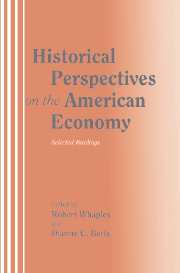Book contents
- Frontmatter
- Contents
- Acknowledgments
- Introduction to students
- Introduction to instructors
- Contributors
- I Introduction
- II Colonial and early national economy
- III Slavery and servitude
- IV The South since the Civil War
- V The rise of American industrial might
- VI Populism
- VII Women in the economy
- VIII The Great Depression
- 18 “Factors accounting for changes in the stock of money”
- 19 “The fall in the demand for money”
- Appendix: Basics of regression
- Glossary
- Name index
- Subject index
19 - “The fall in the demand for money”
Published online by Cambridge University Press: 05 June 2012
- Frontmatter
- Contents
- Acknowledgments
- Introduction to students
- Introduction to instructors
- Contributors
- I Introduction
- II Colonial and early national economy
- III Slavery and servitude
- IV The South since the Civil War
- V The rise of American industrial might
- VI Populism
- VII Women in the economy
- VIII The Great Depression
- 18 “Factors accounting for changes in the stock of money”
- 19 “The fall in the demand for money”
- Appendix: Basics of regression
- Glossary
- Name index
- Subject index
Summary
The outstanding volume of the principal short-term credit instruments in the years around 1929 is shown in Table 1. Commercial paper and bankers' acceptances were used to finance domestic activity and international trade. Brokers' loans were used to finance purchases of other financial assets. And loans by commercial banks included both commercial loans – serving the same purposes as commercial paper – and stock exchange loans. Since most of the brokers' loans listed came from banks, there is substantial double counting in that category.
Most short-term credit was extended in these years in the form of bank loans. These loans were issued in a wide variety of localities and in widely varying circumstances. We cannot hope to describe fully the changes in this variety of local markets. Instead, we look at the rates on bank loans for New York City, which can be expected to reflect any monetary stringency that existed. This rate moved closely with the rates in other cities, although it is somewhat lower than rates charged by smaller banks.
In addition to this interest rate, we will examine the rates on the other instruments listed in Table 1. Although the amounts outstanding of these other instruments were smaller than the volume of bank loans, the movements of rates in these markets can be expected to reflect the changes in monetary conditions in the economy. Since we are looking for evidence of stringency, not following a causal pathway from the money supply to the rest of the economy, we do not have to restrict ourselves to the short-term instruments used most widely.
- Type
- Chapter
- Information
- Historical Perspectives on the American EconomySelected Readings, pp. 596 - 611Publisher: Cambridge University PressPrint publication year: 1995



